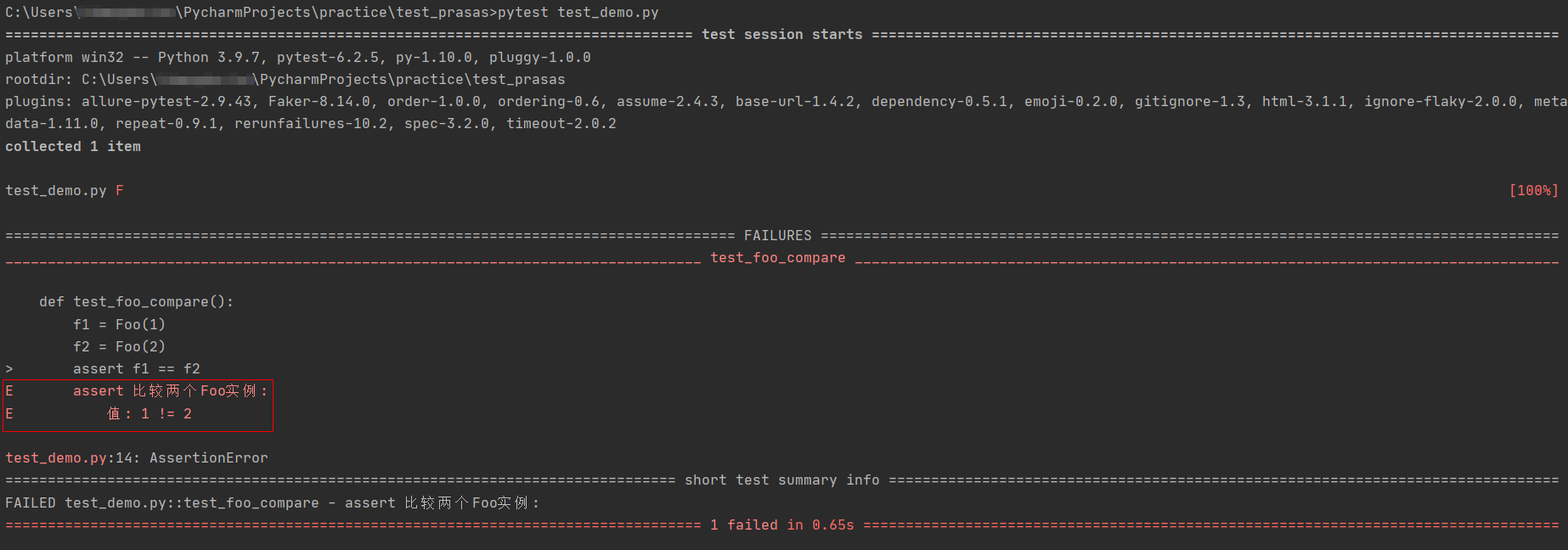pytest之assert断言实现原理解析
assert断言实现原理解析
前言
①断言声明是用于程序调试的一个便捷方式。
②断言可以看做是一个 debug 工具,Python 的实现也符合这个设计哲学。
③在 Python 中 assert 语句的执行是依赖于 __debug__ 这个内置变量的,其默认值为True。且当__debug__为True时,assert 语句才会被执行。
扩展: 有时为了调试,我们想在代码中加一些代码,通常是一些 print 语句,可以写为:
# 在代码中的debug部分,__debug__内置变量的默认值为True【所以正常运行代码执行if __debug__代码块下的调试语句】;当运行程序时加上-o参数,则__debug__内置变量的值为False,不会运行调试语句 if __debug__: pass
一旦调试结束,通过在命令行执行 -O 选项,会忽略这部分代码: python -o main.py
④若执行python脚本文件时加上 -O 参数,则内置变量 __debug__ 为False。则asser语句不执行。【启动Python解释器时可以用 -O 参数来关闭assert语句】
举例:新建 testAssert.py 脚本文件,内容如下:
print(__debug__) assert 1 > 2
当使用 python testAssert.py 运行时,内置属性 __debug__ 会输出 True,assert 1 > 2 语句会抛出 AssertionError 异常。
当使用 python -O testAssert.py 运行时,内置属性 __debug__ 会输出 False,assert 1 > 2 语句由于没有执行不会报任何异常。
assert关键字语法
①assert关键字语法格式如下:
assert expression
等价于:
if not expression: raise AssertionError
②assert后面也可以紧跟参数:即用户可以选择异常的提示值
assert expression [, arguments]
等价于:
if not expression: raise AssertionError(arguments)
③示例如下:
print(__debug__) def foo(s): n = int(s) assert n != 0, 'n is zero!' return 10 / n def main(): foo('0') if __name__ == '__main__': main()
运行结果:

使用assert关键字编写断言
①pytest允许使用python标准的assert表达式写断言;
②pytest支持显示常见的python子表达式的值,包括:调用、属性、比较、二进制和一元运算符等(参考:pytest支持的python失败时报告的演示)
示例:
# test_sample.py def func(x): return x + 1 def test_sample(): assert func(3) == 5
运行结果:

③允许你在没有模版代码参考的情况下,可以使用的python的数据结构,而无须担心丢失自省的问题;
④同时,也可以为断言指定一条说明信息,用于用例执行失败时的情况说明:
assert a % 2 == 0, "value was odd, should be even"
触发期望异常的断言
①可以使用 with pytest.raises(异常类) 作为上下文管理器,编写一个触发期望异常的断言:
import pytest def test_match(): with pytest.raises(ValueError): raise ValueError("Exception 123 raised")
解释:当用例没有返回ValueError或者没有异常返回时,断言判断失败。
②触发期望异常的同时访问异常的属性
import pytest def test_match(): with pytest.raises(ValueError) as exc_info: raise ValueError("Exception 123 raised") assert '123' in str(exc_info.value)
解释: exc_info 是 ExceptionInfo 类的一个实例对象,它封装了异常的信息;常用的属性包括: type 、 value 和 traceback ;
【注意】在上下文管理器的作用域中,raises代码必须是最后一行,否则,其后面的代码将不会执行;所以,如果上述例子改成:
import pytest def test_match(): with pytest.raises(ValueError) as exc_info: raise ValueError("Exception 123 raised") assert '456' in str(exc_info.value)
解释:抛出异常之后的语句不会执行。
③可以给 pytest.raises() 传递一个关键字 match ,来测试异常的字符串表示 str(excinfo.value) 是否符合给定的正则表达式(和unittest中的TestCase.assertRaisesRegexp方法类似)
import pytest def test_match(): with pytest.raises((ValueError, RuntimeError), match=r'.* 123 .*'): raise ValueError("Exception 123 raised") # 异常的字符串表示 是否符合 给定的正则表达式
解释:pytest实际调用的是 re.search() 方法来做上述检查;并且 ,pytest.raises() 也支持检查多个期望异常(以元组的形式传递参数),我们只需要触发其中任意一个。
断言自省
什么是断言自省?
当断言失败时,pytest为我们提供了非常人性化的失败说明,中间往往夹杂着相应变量的自省信息,这个我们称为断言的自省;
那么,pytest是如何做到这样的:
- pytest发现测试模块,并引入他们,与此同时,pytest会复写断言语句,添加自省信息;但是,不是测试模块的断言语句并不会被复写;
去除断言自省
两种方法
- 在需要去除断言自省模块的 docstring 的属性中添加 PYTEST_DONT_REWRITE 字符串;
- pytest命令行方式执行测试用例,添加 --assert=plain 选项;【常用】
示例:
代码如下:
# test_demo.py class Foo: def __init__(self, val): self.val = val def test_foo_compare(): f1 = Foo(1) f2 = Foo(2) assert f1 == f2
①正常运行结果(未去除断言自省):

②去除断言自省:

复写缓存文件
pytest会把被复写的模块存储到本地作为缓存使用,你可以通过在测试用例的根文件夹中的conftest.py里添加如下配置来禁止这种行为:
import sys sys.dont_write_bytecode = True
但是,它并不会妨碍你享受断言自省的好处,只是不会在本地存储 .pyc 文件了。
为失败断言添加自定义的说明
代码如下:
# test_demo.py class Foo: def __init__(self, val): self.val = val def __eq__(self, other): return self.val == other.val def test_foo_compare(): f1 = Foo(1) f2 = Foo(2) assert f1 == f2
运行结果:

此种方式并不能直观的看出来失败的原因;
在这种情况下,我们有两种方法来解决:
①复写Foo类的 __repr__() 方法:
# test_demo.py class Foo: def __init__(self, val): self.val = val def __eq__(self, other): return self.val == other.val def __repr__(self): return str(self.val) def test_foo_compare(): f1 = Foo(1) f2 = Foo(2) assert f1 == f2
运行结果:
②使用 pytest_assertrepr_compare 钩子方法添加自定义的失败说明
# conftest.py from test_demo import Foo def pytest_assertrepr_compare(op, left, right): if isinstance(left, Foo) and isinstance(right, Foo) and op == "==": return [ "比较两个Foo实例:", # 顶头写概要 " 值: {} != {}".format(left.val, right.val), # 除了第一个行,其余都可以缩进 ]
再次执行:



